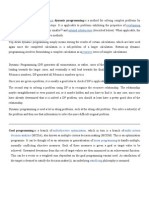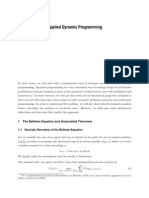0 ratings0% found this document useful (0 votes)
8 viewsDynamminc Programming-Optimality
Dynamic programming is a method for solving complex problems by breaking them into smaller, overlapping subproblems, storing their solutions for efficiency. It is based on the principle of optimality, which states that the optimal solution can be constructed from optimal subproblem solutions. This technique is widely applied in fields like computer science and operations research for various optimization issues.
Uploaded by
quantraptorsCopyright
© © All Rights Reserved
We take content rights seriously. If you suspect this is your content, claim it here.
Available Formats
Download as DOCX, PDF, TXT or read online on Scribd
0 ratings0% found this document useful (0 votes)
8 viewsDynamminc Programming-Optimality
Dynamic programming is a method for solving complex problems by breaking them into smaller, overlapping subproblems, storing their solutions for efficiency. It is based on the principle of optimality, which states that the optimal solution can be constructed from optimal subproblem solutions. This technique is widely applied in fields like computer science and operations research for various optimization issues.
Uploaded by
quantraptorsCopyright
© © All Rights Reserved
We take content rights seriously. If you suspect this is your content, claim it here.
Available Formats
Download as DOCX, PDF, TXT or read online on Scribd
You are on page 1/ 3
Dynamic Programming
Dynamic programming, is a method for solving complex problems by breaking
them down into smaller, overlapping subproblems, where the solutions to
these subproblems are stored and reused to efficiently calculate the optimal
solution to the larger problem; essentially, it's a strategy to tackle intricate
optimization issues by systematically solving smaller, related parts and
combining them to find the best overall outcome. It is defined as a numerical
resolution method allowing to explore in a sampled and systematic way the
space of admissible solutions and to select the global solution meeting the
chosen optimization criterion. Graph theory is often used to formalize this
method.
Key points about dynamic programming:
Principle of Optimality:
The core concept is that the optimal solution to a problem can be
constructed by combining the optimal solutions to its subproblems.
Overlapping subproblems:
Dynamic programming is most effective when a problem contains many
repeating subproblems, allowing for significant efficiency gains by storing
and reusing previously calculated solutions.
Applications:
This technique is widely used in various fields like computer science,
operations research, and artificial intelligence to solve problems like finding
the shortest path, optimal resource allocation, and sequence alignment.
Steps of dynamic programming works:
Break down the problem: Divide the original problem into smaller, more
manageable subproblems.
Solve subproblems: Solve each subproblem individually, storing the results
in a table or memorization structure.
Combine solutions: Use the solutions to subproblems to construct the
optimal solution to the original problem, leveraging the fact that previously
solved subproblems can be reused.
Example of dynamic programming:
Fibonacci sequence: Instead of recalculating Fibonacci numbers at each
step, dynamic programming stores previously calculated values to avoid
redundant computations.
principle of optimality
The principle of optimality is a fundamental aspect of dynamic programming, which
states that the optimal solution to a dynamic optimization problem can be found by
combining the optimal solutions to its sub-problems. The "principle of optimality"
states that within a multi-stage decision process, an optimal solution can be
constructed by making the best decision at each stage, considering only the
current state and the remaining stages, regardless of the decisions made in
previous stages; essentially, the optimal path to the end of a problem is made up
of optimal paths to each sub-problem along the way, which is a core concept in
dynamic programming and attributed to Richard Bellman. While this principle is
generally applicable, it is often only applied for problems with finite or countable state
spaces in order to sidestep measure-theoretic complexities. Therefore, it cannot be
applied to classic models such as inventory management and dynamic pricing models
that have continuous state spaces. To address this, we provide conditions and a self-
contained simple proof that establish when the principle of optimality for discounted
dynamic programming is valid. These conditions shed light on the difficulties that may
arise in the general state space case. We provide examples from the literature that
include the relatively involved case of universally measurable dynamic programming
and the simple case of finite dynamic programming where our main result can be
applied to show that the principle of optimality holds.
Key points about the principle of optimality:
Dynamic Programming Foundation:
This principle is the foundation of dynamic programming, a method for
solving complex optimization problems by breaking them down into smaller,
more manageable subproblems.
Optimal Substructure:
It implies that the optimal solution to a problem can be built from the optimal
solutions to its subproblems.
Decision Making at Each Stage:
When making a decision at any given stage, only the current state and the
remaining stages need to be considered, not the decisions made in the past.
Example:
Imagine planning a road trip to minimize travel time. The principle of optimality
states that the best route from your starting point to your destination can be
found by choosing the optimal route for each individual leg of the journey,
considering only the current location and remaining distance, without worrying
about the choices made earlier in the trip.
You might also like
- Economics - Exercise With Bellman EquationNo ratings yetEconomics - Exercise With Bellman Equation16 pages
- Questions & Answers On Optimal Control SystemsNo ratings yetQuestions & Answers On Optimal Control Systems19 pages
- Dynamic Programming Presentation (Autosaved)No ratings yetDynamic Programming Presentation (Autosaved)17 pages
- Unit-Iii (Part-2) Dynamic ProgrogrammingNo ratings yetUnit-Iii (Part-2) Dynamic Progrogramming42 pages
- File 1716180627 66059 DynamicProgrammingNo ratings yetFile 1716180627 66059 DynamicProgramming9 pages
- ESI 4313 Operations Research 2: Dynamic ProgrammingNo ratings yetESI 4313 Operations Research 2: Dynamic Programming52 pages
- A Survey of Dynamic Programming AlgorithmsNo ratings yetA Survey of Dynamic Programming Algorithms7 pages
- Analysis_and_Application_of_Dynamic_ProgrammingNo ratings yetAnalysis_and_Application_of_Dynamic_Programming5 pages
- Dynamic-Programming.pptx_20241230_132508_0000No ratings yetDynamic-Programming.pptx_20241230_132508_00008 pages
- Process Optimisation: Dynamic ProgrammingNo ratings yetProcess Optimisation: Dynamic Programming35 pages
- Economics 2010c: Lecture 1 Introduction To Dynamic ProgrammingNo ratings yetEconomics 2010c: Lecture 1 Introduction To Dynamic Programming23 pages
- Econ 614 Macroeconomic Theory Ii: The Basic Neoclassical ModelNo ratings yetEcon 614 Macroeconomic Theory Ii: The Basic Neoclassical Model31 pages
- A First Course in Optimization Theory - ContentNo ratings yetA First Course in Optimization Theory - Content8 pages
- Lecture Notes Stochastic Optimization-KooleNo ratings yetLecture Notes Stochastic Optimization-Koole42 pages
- This Document Has Been Classified As CONFIDENTIAL-EXTERNAL by Centenary BankNo ratings yetThis Document Has Been Classified As CONFIDENTIAL-EXTERNAL by Centenary Bank3 pages
- Mastering The Game of Go With Deep Neural Networks and Tree Search - Nature - Nature ResearchNo ratings yetMastering The Game of Go With Deep Neural Networks and Tree Search - Nature - Nature Research15 pages
- EC744 Lecture Note 3 Dynamic Programming Under Certainty: Prof. Jianjun MiaoNo ratings yetEC744 Lecture Note 3 Dynamic Programming Under Certainty: Prof. Jianjun Miao17 pages
- Hubbard, R. G. (1994) - Investment Under Uncertainty Keeping One's Options Open. Journal of Economic Literature, 1816-1831 PDFNo ratings yetHubbard, R. G. (1994) - Investment Under Uncertainty Keeping One's Options Open. Journal of Economic Literature, 1816-1831 PDF17 pages
- 17 Making Complex Decisions: 4 × 3 U, R, D, LNo ratings yet17 Making Complex Decisions: 4 × 3 U, R, D, L8 pages
- A Brief Introduction To Differential GamesNo ratings yetA Brief Introduction To Differential Games16 pages
- Chess AI: Competing Paradigms For Machine Intelligence: Shiva Maharaj Nick Polson Alex TurkNo ratings yetChess AI: Competing Paradigms For Machine Intelligence: Shiva Maharaj Nick Polson Alex Turk15 pages
- Batch Reinforcement Learning: Alan FernNo ratings yetBatch Reinforcement Learning: Alan Fern47 pages
- Hamilton-Jacobi-Bellman Equations and Optimal Control: !birkh Auser Verlag BaselNo ratings yetHamilton-Jacobi-Bellman Equations and Optimal Control: !birkh Auser Verlag Basel10 pages
- Optimal Design of Control Systems Stochastic and Deterministic Problems100% (2)Optimal Design of Control Systems Stochastic and Deterministic Problems423 pages
- Credit Constraints and Poverty Dynamics: Theory, Evidence, and Field Survey StrategyNo ratings yetCredit Constraints and Poverty Dynamics: Theory, Evidence, and Field Survey Strategy52 pages
- Fundamentals of Aerospace Navigation and Guidance 1st Edition Pierre T. Kabamba download100% (2)Fundamentals of Aerospace Navigation and Guidance 1st Edition Pierre T. Kabamba download56 pages
- Unit 3 - Analysis Design of Algorithm - WWW - Rgpvnotes.inNo ratings yetUnit 3 - Analysis Design of Algorithm - WWW - Rgpvnotes.in8 pages

























































































